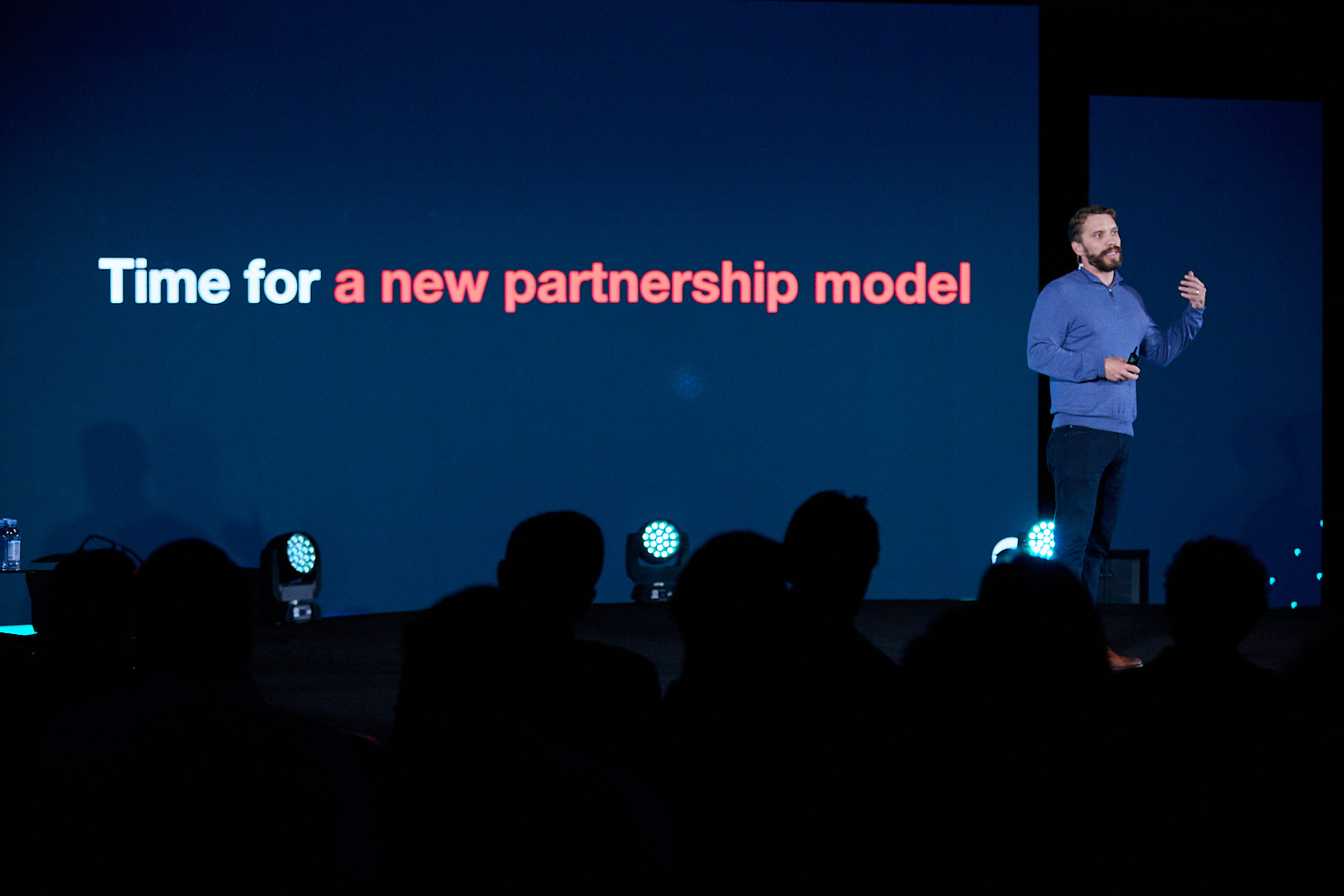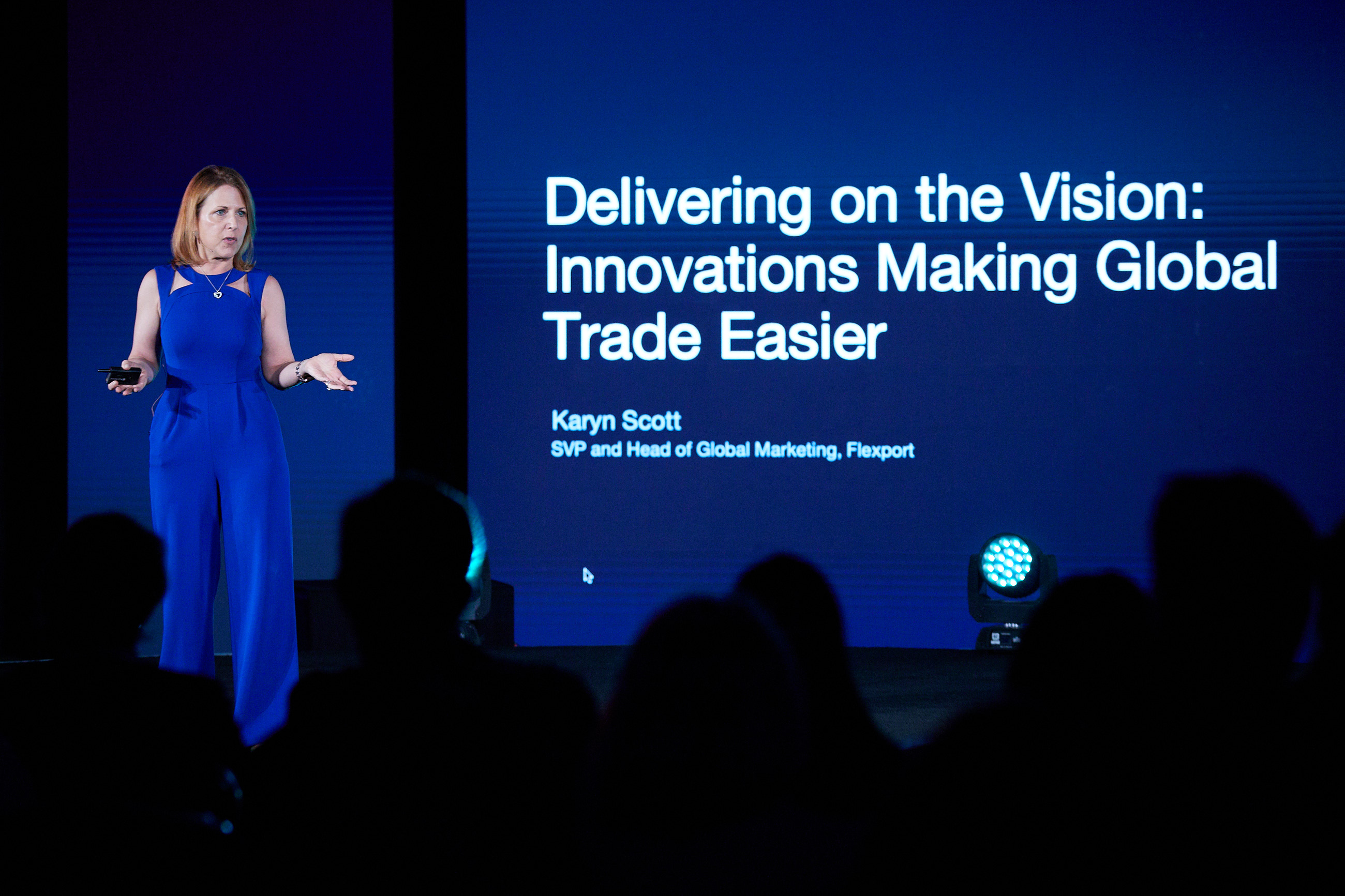
26.09.2019
FORWARD 19 Day One Highlights
FORWARD 19 Day One Highlights
A New Vision for Freight Forwarding, Big Innovations, Tariff Best Practices, and Breakthrough Break-Outs
What a difference a day makes – just ask the hundreds of clients, partners, and industry experts about their last 24 hours at Flexport’s inaugural conference, FORWARD by Flexport.
It was standing room only at the Fairmont Miramar Hotel & Bungalows in Santa Monica, California, as attendees learned actionable strategies from both a revered four-star general and a former White House economic adviser; were challenged and inspired with a new industry paradigm to make global trade easy for everyone; and were introduced to new innovations to help businesses mitigate tariffs and market uncertainty, drive efficiencies across their supply chains, and reduce their carbon footprints.

The three-day gathering began on Wednesday with Flexport CEO and Founder Ryan Petersen welcoming everyone to a very different kind of logistics and supply chain event. “We all know everything changes at the speed of a tweet. And we’re constantly operating in chaos. That said, I think it’s fair to say that none of us has experienced chaos like General McChrystal.”
And with that, Ryan introduced former commander of U.S. and International Forces in Afghanistan and New York Times best-selling author General Stan McChrystal, who took the stage to deliver the opening keynote address. The general shared an actionable primer for effective collaboration and agile decision-making, two cornerstones for navigating today’s chaotic global trade landscape. “Most of us don’t seek chaos,” General McChrystal stated. “Chaos seeks us. The winners in the future will be the people who can work through chaos.”
Asking The Question: “What If?”

Kicking off the first full day of sessions on Thursday, Ryan Petersen opened with a thought-provoking keynote that challenged the status quo and encouraged attendees to ask, “What if?” – to begin thinking differently about how they manage their supply chains and their businesses, in order to stay viable in today’s global trade landscape. Ryan outlined the imperative for logistics to shift from a cost-center model to a growth-center model – one that’s based on how best to serve the customer in all the ways they want to buy, and managed in even closer collaboration with their freight partners.
Spotlighting the “Retail Apocalypse” and the dawn of the direct-to-consumer business model, Petersen observed that only the most agile businesses will survive and thrive. “Many legacy supply chains weren’t built for this. But if you can’t get your product to your customer in one or two days, someone else will. Those who are getting the message are the upstarts and innovative global brands that have learned to reinvent themselves.”
Just as this new way of doing business requires a change in the business model itself, Ryan outlined how it also takes a shift in logistics – requiring an integration of technology, infrastructure, and expertise. ”Infrastructure is key. But you have to connect it to the real world [with technology]. Doing tech alone is just a thin veneer, because it doesn’t connect to the deeper infrastructure. And the problems of the industry can’t be solved with tech alone; it needs humans. Relationships are more important than ever. I’ve heard from many that this industry is about relationships and there’s no room for tech. I think that’s a set up for mediocrity.”
Delivering On The Vision

Karyn Scott, Flexport’s SVP and Global Head of Marketing, then took the stage to answer the “What Ifs” with tangible “Here’s Hows.” She detailed several new Flexport innovations that are empowering companies that have goods to move, the factories that make them, and the truckers, airlines, and ocean carriers that get them from A to B.
The Flexport Platform Experience 2.0: Karyn led the audience on a whistle-stop tour of the just-launched, dramatically enhanced (and enthusiastically received) Flexport technology platform – which boasts a totally new dashboard for a better workflow experience. The new functionality helps users align shipments to their business priorities, and enables them to collaborate seamlessly with teams and suppliers. Karyn stressed how the new platform provides stakeholders exactly what’s most important to them: “Whether you’re a logistics manager who needs to see the specifics of a certain shipment, or you’re an executive who wants a quick snapshot of the business, this enhanced platform gives you those insights at a glance." Read more to explore our biggest platform refresh to date.
Warehouse App: Karyn also touched on Flexport’s Warehouse App, which gives clients unprecedented visibility and control over first- and last-mile milestones, so they can save time and reduce accessorial costs. In addition, she showcased how the app seamlessly connects with Flexport's trucking app. In fact, 87% of all truckers moving Flexport shipments now use this technology, allowing them to mark when containers are picked up from port and when they’ve been delivered. “The warehouse can now let truckers know when containers have been unloaded and are ready for pickup — minimizing the chance of demurrage fees,” said Karyn. To illustrate the benefits of the technology, Karyn shared a video featuring Flexport client RoxAnne Thomas, U.S. Transportation Manager at Gerber.
Embedded content: https://share.vidyard.com/watch/HaA7cUk15N5tZLTEyrpuJW?
Carbon Offsets: How do you cap off two incredible innovations that are making it even easier for clients to move their freight? By moving their cargo more sustainably as well! Karyn provided an update from Flexport.org on our Carbon Offset program, sharing that in the past year we’ve helped our clients offset more than 33,500 tonnes of CO2. To put that in perspective, that’s the same as driving around the equator in a regular Honda Civic more than 3,300 times! Karyn also teed up very some big news to come from Flexport.org in our Sustainability panel tomorrow. Stay tuned for more information...
Tariff Insights, Data and Multimodal Strategies, and Product Break-Outs

The day continued with a series of high-energy sessions, filled with lively discussions about some of today’s most pressing supply chain issues. Chiefly among them: tariffs. Flexport Chief Economist Phil Levy moderated a panel with Ulrik Sanders of Boston Consulting Group and Karena Parliment, CFO of Kenroy Home. Discussing the sudden impact of the U.S.-China trade war, the panel explored tariff mitigation strategies and their outlook for the future. You can see some of the Flexport research Dr. Levy shared in this recent article.

Flexport COO Sanne Manders and Maersk CIO/CTO Adam Banks, followed with a fireside chat about how data is driving business optimization and transformation in logistics. “Before you can transform an industry, you have to digitalize it. [Shippers] should put pressure on their organizations to invest in more technology so that we can all be more seamless,” said Banks. Manders agreed, suggesting, “To be more customer centric and efficient, we have to get rid of this human-to-human relay race and replace it with a machine-to-machine relay race. Data is the way to unlock this.”

Throughout the afternoon, attendees chose from a series of break-out sessions on Flexport services, including Flexport Capital, Customs, and Insurance. The day wrapped up with a mainstage discussion focused on strategies for managing turbulence with a multimodal supply chain strategy. You can learn more from Neel about some of these strategies in this recent webinar on the current trends in airfreight.
A networking reception and dinner at poolside capped the day, giving everyone a chance to relax and recharge before the final day of the conference.
Want to see what’s happening as it happens? Follow @flexport on Twitter and join the conversation with hashtag #FORWARDByFlexport.



